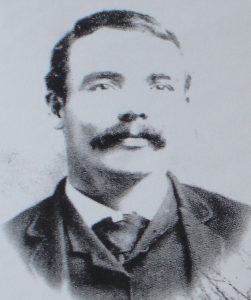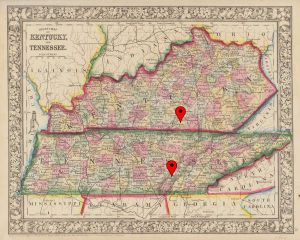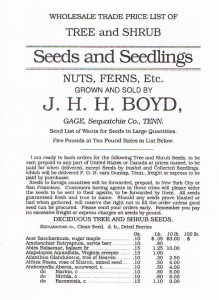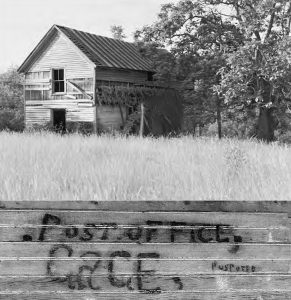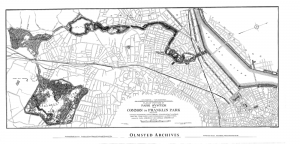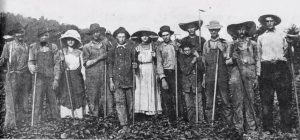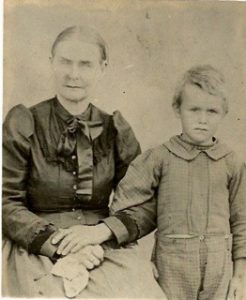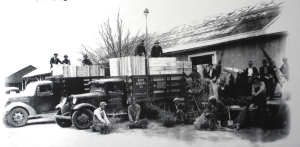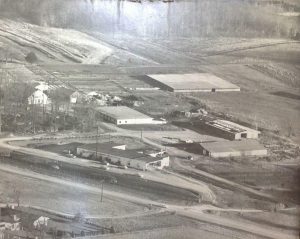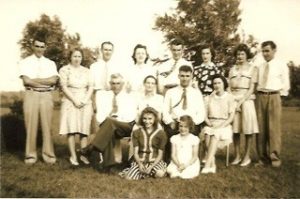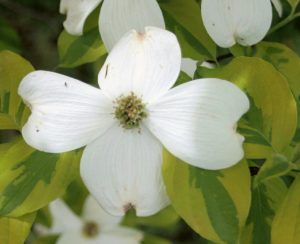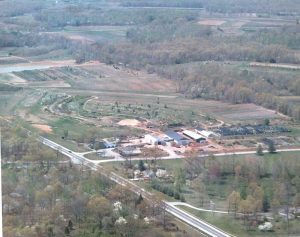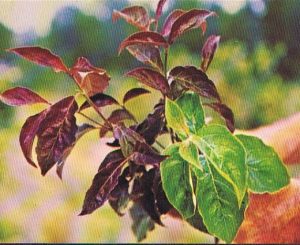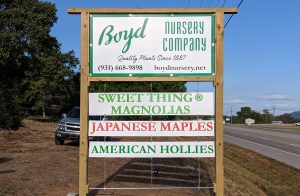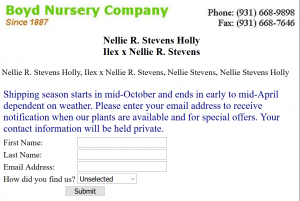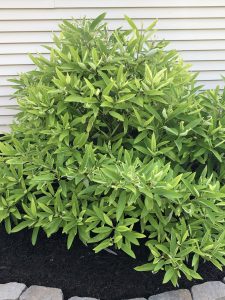The Rest of the Story
Boyd Nursery Timeline
Jonathan Henry Harrison “JHH” Boyd is born to Fernando Campbell Boyd and Jane Winchester Boyd of Roane County, Tennessee on February 11, 1861.
The Unionist Boyd Family had fled Tennessee immediately prior to the Civil War. Living in Albany, Kentucky for the duration of the war, the Boyd Family returns to Tennessee around 1868, settling in Sequatchie County.
After purchasing two farms early in the 1870s, JHH Boyd moves to the Cagle community. His initial interest in plants is piqued when many of his grazing cows mysteriously grow ill and die. Writing several horticultural publications across the northeast, JHH Boyd learns from the editor of the Farm Journal of Philadelphia that the Bubby bush, (Calycantheus floridus) is responsible for the livestock poisoning. He also learns that the plant is used in 19th century medications. JHH Boyd Account
Following his investigation, JHH Boyd attracts the interest of several naturalist-writers/horticulturalists, including Mr. Emerson E. Sterns and Dr. Robert G. Eccles. JHH Boyd makes his first sale of Bubby seed pods for $5.00 (roughly $135 today) to Mr. Sterns, and in turn, Mr. Sterns agrees to show JHH Boyd the other native species of value in the area and their respective uses. The order encourages JHH Boyd to gather and grow additional plants for sell.
After making his first sale, JHH Boyd sets out to learn all he can of the local flora. He contacts experts and purchases books to study regarding the plants of the area. He even becomes a noted spelunker, seeking ever more effective plant fertilizers in Higginbotham Cave. In 1887, JHH Boyd forms his first business, JHH Boyd, Nurseryman and Seed Collector, on his farm at the head of the Collins River in Gage, TN. JHH Boyd Message in Higginbotham Cave
During the early 1890s, Chauncey D. Beadle, approaches JHH Boyd on behalf of the Biltmore Estate. JHH Boyd proceeds to make a sale of close to 1 million seedlings to either the Biltmore forests or Biltmore Nursery (it is currently unclear which). The seedlings are transported via 20 wagons from Boyd’s mountain nursery to the valley below and shipped via refrigerator box car. Over the following years, JHH Boyd conducts additional sales and purchases from Biltmore Nursery prior to its closure in 1916.
Thanks in part to the high volume of plant stock being shipped worldwide, JHH Boyd successfully petitions the U.S. Post Office Department to establish the Gage (Gauge), Tennessee Post Office. JHH Boyd acts as Postmaster, and his family cabin serves as the official community Post Office.
JHH Boyd makes a series of sales to the Olmsted Brothers landscape architectural firm to help establish The Emerald Necklace park system in Boston, Massachusetts and the Iroquois Park in Louisville, Kentucky. Correspondence between the two parties continue from 1898-1899. Correspondence Letters
JHH Boyd forms Forest Nursery and Seed Company with George W. Perry in 1902. Working together with the Perry brothers, JHH Boyd and the Forest Nursery and Seed Company make sales as far as China, Japan, France, and England – even collecting and selling cacti collected from Mexico. Early Forest Nursery and Seed Company Catalogue
Driven by his expanding business to reduce shipping costs and improve the productivity of his farm, JHH Boyd moves his family and farm operations to Irving College, Tennessee and sells his 585 acre mountain farm. Operating closer to rail lines and in more fertile soil, Boyd’s nursery thrives.
JHH Boyd & George Perry sell Forest Nursery and Seed Company to AP Hill. Soon after, JHH Boyd starts Riverview Nursery and Seed Company in association with his son-in-law Forrest Phifer across the Collins River from Irving College. JHH Boyd takes on a managerial/advisory role.
Sons of JHH Boyd, Fernando Campbell ‘FC’ Boyd, Sr. (1888) and James Reed ‘JR’ Boyd (1890) purchase Forest Nursery and Seed Company back from A.P. Hill and become partners at Forest Nursery and Seed Company – Boyd Brothers – working alongside their father until his death on February 21, 1924 (learn more about JHH Boyd). In the years from 1914 to 1925 the company enjoys substantial growth, and during this period the “and Seed” is gradually omitted from the company name. In 1925, Forest Nursery Company is incorporated with F. C. Boyd, President; John L. Colville, Vice President; J. R. Boyd, Secretary; and D. P. Henegar, Treasurer. Southern Nurserymen’s Association 1916 – FC Boyd, Sr.
In 1929, JR Boyd purchases Forest Nursery Company interests from FC Boyd. FC Boyd forms Boyd Nursery Company with the focus interest on mail order retail nursery stock. FC Boyd locates his new business in Depot Bottom of Warren County. His first mail order catalog (printed in glorious color) nearly bankrupts the infant company as the Great Depression begins, but the risk pays off. Sales begin to pour in, including notable sales to then Governor of New York, Franklin D. Roosevelt. Within the decade Boyd Nursery Company has expanded through what will eventually become the Westwood community of McMinnville. Boyd Nursery Company 1930s
FC Boyd expands the rapidly growing company to Morrison, Tennessee. During the Second World War, operations on the farm continue in a limited role. FC Boyd’s sons, Robert (navy), Austin (army), Clark (army), and Hubert (army) proudly serve. Boyd Nursery Company participates in Victory Garden activities. By the early 1960s, Boyd Nursery Company employs nearly 200 people, and owns nearly 8000 acres of land. During this period, it is believed that Boyd Nursery Company is the 3rd largest provider of ornamental plant stock in the world. Boyd Nursery Company 1940s-60s
After a decline in health, FC Boyd turns the business and its management over to his sons, Henry N. Boyd, J. Austin Boyd, Fernando Campbell “Junior” Boyd, Jr., and Clark C. Boyd.
FC Boyd, Jr. on behalf of Boyd Nursery Company patents the First Lady Dogwood. The cultivar, first discovered in 1957 and observed flowering in 1967, is noted for its distinctive features. The tree has brilliant green and golden variegated foliage, white flowers, and maroon and pink fall color. Its plant patent number is #2916, registered on October 25, 1967.
On December 31, 1973, Boyd Nursery Company merges with Harvest Corporation of Nashville, Tennessee. In announcing the merger, Henry N. Boyd states that Harvest Corporation will serve as the holding company and Boyd Nursery as the operating company. Unfortunately, the agreement results in disaster. Shortly after the merger, Harvest Corporation goes bankrupt. The Boyd farm continues to operate, but the company of the same name is no more. In spite of the setback, the Boyd family presses on. By 1976, they form a new partnership named Boyd Brothers Nursery. Boyd Brothers Nursery operates until the death of Henry Boyd in 2001.
First observed by Clark C. Boyd as a chance seedling in 1966, Boyd Brothers Nursery patents the Purple Glory Dogwood on March 2, 1979. With leaves that are dark purple in coloration and blossoms of four dark red bracts, the plant offers a unique appeal for dogwood enthusiasts to this day. Its plant patent number is #4627.
Forging his own path, the grandson of FC Boyd, Fernando Campbell “Campbell” Boyd, III, starts Black Walnut Inc. in 1995. After successfully operating the business for six years, Campbell Boyd inherits the Boyd Nursery Company name in 2001.
From 1995 to 2001, Campbell Boyd learns the ins and outs of early website design at his Black Walnut, Inc. site. With the aid of website designer Patrick Pedigo, Campbell Boyd offers retail and wholesale options online. After inheriting Boyd Nursery Company, www.boydnursery.net is launched in 2004. Early site versions require customers to call-in or mail-in forms for order placement; however, by 2009 a fully online checkout option becomes available. A replica of Boyd Nursery’s parent website, Black Walnut, can be found here.
Campbell Boyd of Boyd Nursery Company and George Dodson of Sleepy Hollow Nursery patent the Sweet Thing Magnolia on April 15, 2004. After George discovers the tree in a block of seedlings that were planted in 1990 at Sleepy Hollow Nursery, Campbell manages its successful propagation. The tree has cream-colored, lemon-scented flowers throughout the summer and is significant for its compact habit. Its plant patent number is #17814. More information can be found at www.sweetthingmagnolia.com.

